Cell Biology Antibodies 11
Anti-ADRA1B Antibody (CAB7872)
- SKU:
- CAB7872
- Product Type:
- Antibody
- Reactivity:
- Human
- Reactivity:
- Mouse
- Host Species:
- Rabbit
- Isotype:
- IgG
- Antibody Type:
- Polyclonal Antibody
- Research Area:
- Cell Biology
Description
| Antibody Name: | Anti-ADRA1B Antibody |
| Antibody SKU: | CAB7872 |
| Antibody Size: | 20uL, 50uL, 100uL |
| Application: | WB |
| Reactivity: | Human, Mouse |
| Host Species: | Rabbit |
| Immunogen: | A synthetic peptide of human ADRA1B |
| Application: | WB |
| Recommended Dilution: | WB 1:500 - 1:2000 |
| Reactivity: | Human, Mouse |
| Positive Samples: | HL-60, Jurkat, MCF7, HepG2, Mouse heart |
| Immunogen: | A synthetic peptide of human ADRA1B |
| Purification Method: | Affinity purification |
| Storage Buffer: | Store at -20'C. Avoid freeze / thaw cycles. Buffer: PBS with 0.02% sodium azide, 50% glycerol, pH7.3. |
| Isotype: | IgG |
| Sequence: | Email for sequence |
| Gene ID: | 147 |
| Uniprot: | P35368 |
| Cellular Location: | Cell membrane, Multi-pass membrane protein, Nucleus membrane |
| Calculated MW: | 56kDa |
| Observed MW: | 50kDa |
| Synonyms: | ADRA1B, ADRA1, ALPHA1BAR |
| Background: | Alpha-1-adrenergic receptors (alpha-1-ARs) are members of the G protein-coupled receptor superfamily. They activate mitogenic responses and regulate growth and proliferation of many cells. There are 3 alpha-1-AR subtypes: alpha-1A, -1B and -1D, all of which signal through the Gq/11 family of G-proteins and different subtypes show different patterns of activation. This gene encodes alpha-1B-adrenergic receptor, which induces neoplastic transformation when transfected into NIH 3T3 fibroblasts and other cell lines. Thus, this normal cellular gene is identified as a protooncogene. This gene comprises 2 exons and a single large intron of at least 20 kb that interrupts the coding region. |
| UniProt Protein Function: | ADRA1B: a G protein-coupled catecholamine receptor that activates mitogenic responses and regulates growth and proliferation of many cells. There are 3 alpha-1-AR subtypes: alpha-1A, -1B and -1D, all of which signal through the Gq/11 family of G-proteins and different subtypes show different patterns of activation. Can induce neoplastic transformation when transfected into cell lines. Can regulate the phosphorylation status of the STAT3 pathway. Mediates blood pressure and aorta contractile responses induced by alpha-1 agonists. Activates a phosphatidylinositol second messenger system. |
| UniProt Protein Details: | Protein type:GPCR, family 1; Receptor, GPCR; Membrane protein, integral; Membrane protein, multi-pass Chromosomal Location of Human Ortholog: 5q33.3 Cellular Component: nuclear membrane; integral to plasma membrane; plasma membrane; nucleus Molecular Function:protein heterodimerization activity; alpha1-adrenergic receptor activity Biological Process: adult heart development; vasoconstriction of artery involved in baroreceptor response to lowering of systemic arterial blood pressure; positive regulation of the force of heart contraction by epinephrine-norepinephrine; multicellular organismal development; response to amphetamine; response to morphine; locomotory behavior; glucose homeostasis; positive regulation of glycogen catabolic process; G-protein signaling, coupled to cAMP nucleotide second messenger; organ growth; cell proliferation; G-protein coupled receptor protein signaling pathway; cell-cell signaling; positive regulation of MAPKKK cascade; behavioral response to cocaine; regulation of vasoconstriction; visual learning; blood vessel remodeling; cell growth; positive regulation of heart rate by epinephrine-norepinephrine; negative regulation of glycogen catabolic process |
| NCBI Summary: | Alpha-1-adrenergic receptors (alpha-1-ARs) are members of the G protein-coupled receptor superfamily. They activate mitogenic responses and regulate growth and proliferation of many cells. There are 3 alpha-1-AR subtypes: alpha-1A, -1B and -1D, all of which signal through the Gq/11 family of G-proteins and different subtypes show different patterns of activation. This gene encodes alpha-1B-adrenergic receptor, which induces neoplastic transformation when transfected into NIH 3T3 fibroblasts and other cell lines. Thus, this normal cellular gene is identified as a protooncogene. This gene comprises 2 exons and a single large intron of at least 20 kb that interrupts the coding region. [provided by RefSeq, Jul 2008] |
| UniProt Code: | P35368 |
| NCBI GenInfo Identifier: | 116241241 |
| NCBI Gene ID: | 147 |
| NCBI Accession: | P35368.3 |
| UniProt Secondary Accession: | P35368,B0LPE1, |
| UniProt Related Accession: | P35368 |
| Molecular Weight: | 520 |
| NCBI Full Name: | Alpha-1B adrenergic receptor |
| NCBI Synonym Full Names: | adrenoceptor alpha 1B |
| NCBI Official Symbol: | ADRA1B |
| NCBI Official Synonym Symbols: | ADRA1; ALPHA1BAR |
| NCBI Protein Information: | alpha-1B adrenergic receptor; alpha-1B adrenoceptor; alpha-1B adrenoreceptor; alpha-1B-adrenergic receptor; adrenergic, alpha-1B-, receptor |
| UniProt Protein Name: | Alpha-1B adrenergic receptor |
| UniProt Synonym Protein Names: | Alpha-1B adrenoreceptor; Alpha-1B adrenoceptor |
| Protein Family: | Alpha-1B adrenergic receptor |
| UniProt Gene Name: | ADRA1B |
| UniProt Entry Name: | ADA1B_HUMAN |







